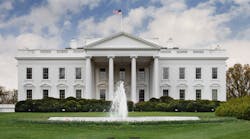Biden Signs Order to Create More Secure Supply Chains for Essential Goods
On February 24, President Biden signed an Executive Order to "help create more resilient and secure supply chains for critical and essential goods," the White House said in a statement.
The administration pointed to the strain of shortages of essential products—from medicine to food to computer chips as providing hardship to American citizens. "Last year’s shortages of personal protective equipment (PPE) for front-line healthcare workers at the beginning of the COVID-19 pandemic were unacceptable." the statement reads.
The release also noted the shortages of automotive semiconductor chips, which causes shutdowns at factories and " hurt U.S. workers."
The Executive Order launches a comprehensive review of U.S. supply chains and directs federal Departments and Agencies to identify ways to secure U.S. supply chains against a wide range of risks and vulnerabilities.
First, the order directs an immediate 100-day review across federal agencies to address vulnerabilities in the supply chains of four key products.
- APIs are the part of a pharmaceutical product that contains the active drug. In recent decades, more than 70 percent of API production facilitators supplying the U.S. have moved offshore. This work will complement the ongoing work to secure supply chains needed to combat the COVID-19 pandemic.
- Critical minerals are an essential part of defense, high-tech, and other products. From rare earths in our electric motors and generators to the carbon fiber used for airplanes—the United States needs to ensure we are not dependent upon foreign sources or single points of failure in times of national emergency.
- Semiconductors and Advanced Packaging. The United States is the birthplace of this technology and has always been a leader in semiconductor development. However, over the years we have underinvested in production—hurting our innovative edge—while other countries have learned from our example and increased their investments in the industry.
- Large capacity batteries, such as those used in electric vehicles: As we take action to tackle the climate crisis, we know that will lead to a large demand for new energy technologies like electric vehicle batteries. By identifying supply chain risks, we can meet the President’s commitment to accelerate U.S. leadership of clean energy technologies. For example, while the U.S. is a net exporter of electric vehicles, we are not a leader in the supply chain associated with electric battery production. The U.S. could better leverage our sizeable lithium reserves and manufacturing know-how to expand domestic battery production.
The 100-day review will identify near-term steps the administration can take, including with Congress, to address vulnerabilities in the supply chains for these critical goods.
Second, the order calls for a more in-depth one-year review of a broader set of U.S. supply chains. The one-year review will include:
- A focus on six key sectors: the defense industrial base; the public health and biological preparedness industrial base; the information and communications technology (ICT) industrial base; the energy sector industrial base; the transportation industrial base; and supply chains for agricultural commodities and food production.
- A set of risks for agencies to consider in their assessment of supply chain vulnerabilities: Agencies and Departments are directed to review a variety of risks to supply chains and industrial bases. For example, these reviews must identify critical goods and materials within supply chains, the manufacturing or other capabilities needed to produce those materials, as well as a variety of vulnerabilities created by the failure to develop domestic capabilities. Agencies and Departments are also directed to identify locations of key manufacturing and production assets, the availability of substitutes or alternative sources for critical goods, the state of workforce skills and identified gaps for all sectors, and the role of transportation systems in supporting supply chains and industrial bases.
- Recommendations on actions that should be taken to improve resiliency: Agencies are directed to make specific policy recommendations to address risks, as well as proposals for new research and development activities.
- A sustained commitment to supply chain resiliency: The government will commit to a regular, ongoing process of reviewing supply chain resilience, including a quadrennial review process.
- Consultation with external stakeholders: The government cannot secure supply chains on its own. It requires partnership and consultation with the American people. The E.O. directs the Administration to consult widely with outside stakeholders, such as those in industry, academia, non-governmental organizations, communities, labor unions, and State, local, territorial, and Tribal governments.



